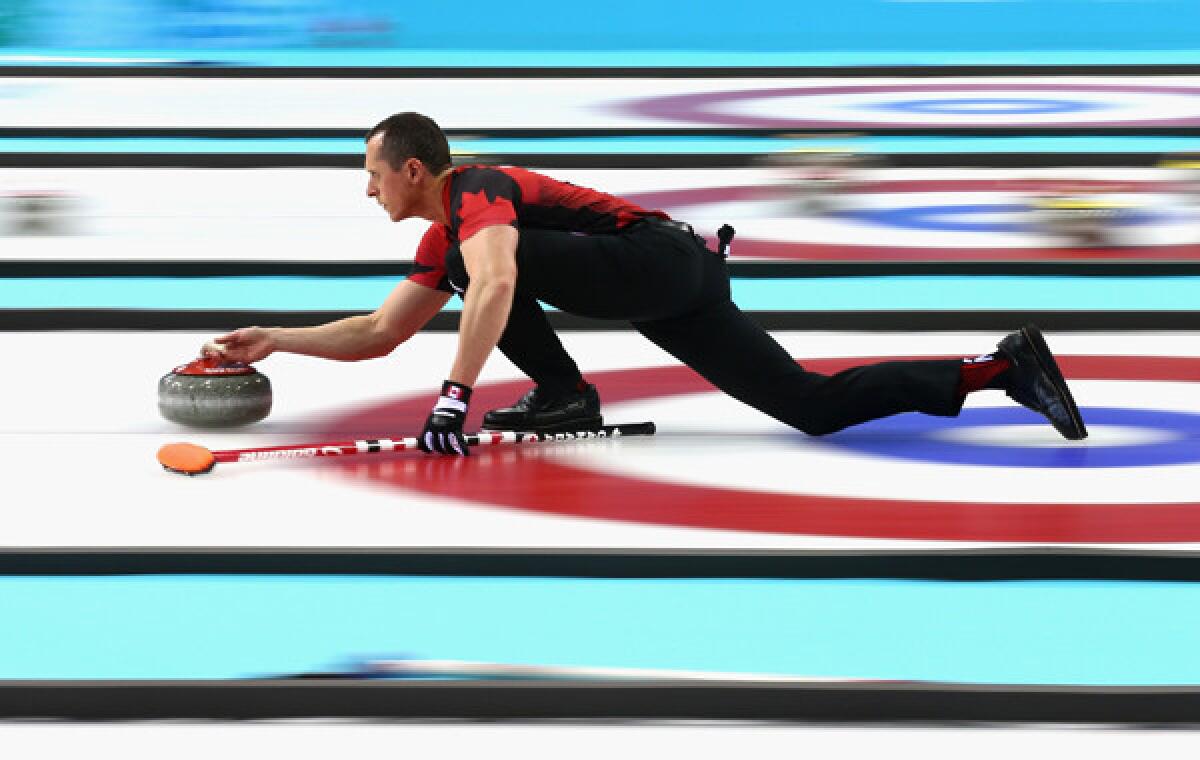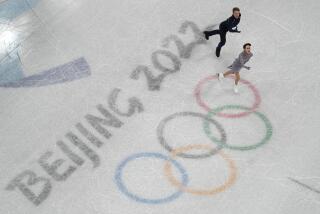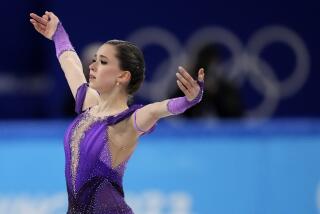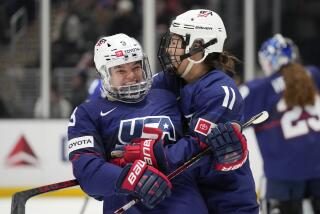Those snide remarks? U.S. curling team members let them slide

SOCHI, Russia — The Canadian guy with bulging tattooed biceps is pumping his fist and glaring. Two Norwegian guys with colorfully checkered pants are hunched over and shimmying. A Swiss woman is screaming at her friends with a mouth so wide one can examine her pierced tongue.
This is not some funky corner bar at the Olympic village or some hip Olympic reality show.
This is cool, cool curling.
Go ahead, laugh, roll those eyes, make those jokes like the one bellowed by the Russian reporter outside the Ice Cube Curling Center on Monday night.
“I’m going inside to learn how to sweep that broom real fast so I can make my wife do better in the kitchen,” he proclaimed with a howl.
Seriously, keep it going, rip the Olympics for allowing a drinking game to become a sport, bring up beer guts and cigarette breaks and mispronounce it in the most cholesterol-laden way possible.
“I once had somebody come up to me and ask, ‘What exactly is curdling?’” said Rick Patzke, the chief operating officer of USA Curling.
Finished? Good. Now check the reality of this ancient treasure, which opened a 12-day Olympic run Monday that gives it more face time here than any other sport but hockey. It’s the Olympics’ most relatable and honest of endeavors, an odd mixture of shuffleboard and chess featuring unassuming athletes seemingly lifted from your next-door neighbor’s porch.
“Little quiet for us tonight, but just wait until our big cheering section gets here tomorrow,” said John Shuster, the U.S skip (captain) after Monday’s opening 7-4 loss to Norway. “Could be as many as a dozen people here.”
They don’t look like those other winter athletes who are hidden underneath helmets and goggles and spandex. They essentially compete in T-shirts and sweat pants and even clunky black shoes. They work on ice but are too cool for skates.
“I’m just a guy you’d find on the streets of Duluth,” said Shuster, 31, who with his three younger teammates are a collection of smiling Minnesota dudes with real jobs, sensible lives and intact priorities. Jeff Isaacson is a middle-school science teacher who says that educating children is much harder than the Olympics. Shuster manages a steakhouse one day a week when he’s not being a stay-at-home dad for 9-month-old Luke.
“Literally, in the morning, when he’s ready to go down for a nap, I put him in the car seat and go down to the curling club to practice while he sleeps,” Shuster said. “He sleeps longer, I can practice longer.”
They also don’t sound like other winter athletes, as they are miked up for their entire matches, which allows viewers to hear them argue, occasionally curse and exhort their teammates with phrases like, “Hurry! Hurry harder!” as they sweep the stone down the ice.
“It’s crazy, everybody can hear everything, so I always tell myself to talk like I would talk to my mother,” said Shuster. “But it makes our sport so much more watchable and lets people connect with us.”
Since 2002 in the United States, they have connected at a 52% growth rate, with about 16,500 people curling in 43 states, including folks at the Southland’s Hollywood Curling Club and Orange County Curling Club. This number will spike again after the Olympics, but actually because of a misconception that is endemic to curling’s success.
“One of the attractions is that everybody thinks they can do it,” said Patzke. “People think, ‘I couldn’t fly off the mountains on a ski, but I certainly push a rock with a broom.’”
For one, it’s not a simple rock, but a chunk of granite that weighs about 40 pounds and is purchased for the Olympics from an island off the coast of Scotland, where curling was born in the 1500s. Curling is the only Olympic sport that not only honors its roots in equipment, but in ceremony, as every match begins with a bellowing parade of bagpipe players in full kilt.
Also, it’s not a real broom, but a $250 piece of sweeping equipment, a difference in perception that makes the players bristle.
“People ask me if I sweep around the house,” says Isaacson with a sigh.
Folks think they all drink beer. The U.S. teams won’t have a beer until after the competition. Folks think they are out of shape. Check out the arms on some of those guys. Since the game returned to the Olympics in 1998 after a 74-year absence, the participants have become better athletes who, in Monday’s opening here, attracted an arena of screaming young fans.
With websites devoted to the photogenic Russian women’s team and a Facebook page for the Norwegians’ pants, curling will spend the next two weeks grabbing good spotlight and shooting down tired critics.
It uses funky equipment to shoot a silly object at a strange target? How does that make it different from golf? Its rules are convoluted and its athletes are average? Doesn’t that describe baseball?
And, hey, let’s see Tiger Woods or Derek Jeter endure what happened to the U.S. curling captain on Monday night.
Shuster was late to the postgame interviews because his credential somehow disappeared during the match. Officials apparently didn’t trust that he had just competed and wouldn’t let him leave the playing surface until the credential was recovered.
“Can’t go anywhere without that thing,” he told reporters, smiling. “Just like you.”
Twitter: @billplaschke
More to Read
Go beyond the scoreboard
Get the latest on L.A.'s teams in the daily Sports Report newsletter.
You may occasionally receive promotional content from the Los Angeles Times.







